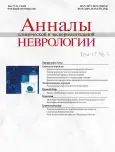Oral risdiplam for specific therapy in adult patients with 5q spinal muscular atrophy in the Moscow region
- Authors: Novikova E.S.1
-
Affiliations:
- M.F. Vladimirsky Moscow Regional Research and Clinical Institute
- Issue: Vol 17, No 3 (2023)
- Pages: 88-93
- Section: Clinical analysis
- URL: https://journals.rcsi.science/2075-5473/article/view/253964
- DOI: https://doi.org/10.54101/ACEN.2023.3.11
- ID: 253964
Cite item
Full Text
Abstract
5q spinal muscular atrophy (SMA) is a rare autosomal recessive neuromuscular disease characterized by gradual loss of motor neurons with progressive muscle weakness and atrophy. A specific therapy has changed the prognosis for such patients, prevented worsening disability, and improved the quality of life. Here are presented follow-up data for 13 patients with SMA aged 19–42 years receiving oral therapy for 2021–2023. Changes in motor functions were assessed using a Revised Upper Limb Module (RULM) every 6 months. According to the follow-up data for risdiplam use in adult patients with SMA in the Moscow region, condition can be stabilized and motor functions can be improved even in patients with a severe neurological deficit at advanced disease stages.
Full Text
##article.viewOnOriginalSite##About the authors
Ekaterina S. Novikova
M.F. Vladimirsky Moscow Regional Research and Clinical Institute
Author for correspondence.
Email: novikova.ekserg@yandex.ru
ORCID iD: 0000-0001-6004-9111
SPIN-code: 7300-0301
Scopus Author ID: 57200326998
neurologist at the Orphan diseases center, junior researcher, M.F. Vladimirsky Moscow Regional Research and Clinical Institute, Moscow, Russia
Russian Federation, MoscowReferences
- Verhaart I.E.C., Robertson A., Leary R. et al. A multi-source approach to determine SMA incidence and research ready population. J. Neurol. 2017;264(7):1465–1473. DOI :10.1007/s00415-017-8549-1
- Verhaart I.E.C., Robertson A., Wilson I.J. et al. Prevalence, incidence and carrier frequency of 5q-linked spinal muscular atrophy — a literature review. Orphanet. J. Rare Dis. 2017;12(1):124. doi: 10.1186/s13023-017-0671-8
- Lefebvre S., Bürglen L., Reboullet S. et al. Identification and characterization of a spinal muscular atrophy-determining gene. Cell. 1995;80(1):155–165. doi: 10.1016/0092-8674(95)90460-3
- Yeo C.J.J., Simmons Z., De Vivo D.C., Darras B.T. Ethical perspectives on treatment options with spinal muscular atrophy patients. Ann. Neurol. 2022;91(3):305–316. doi: 10.1002/ana.26299
- Ruggiu M., McGovern V.L., Lotti F. et al. A role for SMN exon 7 splicing in the selective vulnerability of motor neurons in spinal muscular atrophy. Mol. Cell Biol. 2012;32(1):126–138. doi: 10.1128/MCB.06077-11
- Simone C., Ramirez A., Bucchia M. et al. Is spinal muscular atrophy a disease of the motor neurons only: pathogenesis and therapeutic implications? Cell Mol. Life Sci. 2016;73(5):1003–1020. doi: 10.1007/s00018-015-2106-9
- Chaytow H., Huang Y.T., Gillingwater T.H., Faller K.M.E. The role of survival motor neuron protein (SMN) in protein homeostasis. Cell Mol. Life Sci. 2018;75(21):3877–3894. doi: 10.1007/s00018-018-2849-1
- Nash L.A., Burns J.K., Chardon J.W. et al. Spinal muscular atrophy: more than a disease of motor neurons? Curr. Mol. Med. 2016;16(9):779–792. doi: 10.2174/1566524016666161128113338
- Burnett B.G., Muñoz E., Tandon A. et al. Regulation of SMN protein stability. Mol. Cell Biol. 2009;29(5):1107–1115. doi: 10.1128/MCB.01262-08
- Monani U.R., Lorson C.L., Parsons D.W. et al. A single nucleotide difference that alters splicing patterns distinguishes the SMA gene SMN1 from the copy gene SMN2. Hum. Mol. Genet. 1999;8(7):1177–1183. doi: 10.1093/hmg/8.7.1177
- Селивёрстов Ю.А., Клюшников С.А., Иллариошкин С.Н. Спинальные мышечные атрофии: понятие, дифференциальная диагностика, перспективы лечения Нервные болезни. 2015;(3):9–17. Seliverstov Yu.A., Klyushnikov S.A., Illarioshkin S.N. Spinal muscular atrophy: concept, differential diagnosis, treatment prospects Nervous diseases. 2015;(3):9–17. (In Russ.)
- Cartwright M.S., Upadhya S. Selecting disease-modifying medications in 5q spinal muscular atrophy. Muscle Nerve. 2021;64(4):404–412. doi: 10.1002/mus.27358
- Mercuri E., Bertini E., Iannaccone S.T. Childhood spinal muscular atrophy: controversies and challenges. Lancet Neurol. 2012;11(5):443–452. doi: 10.1016/S1474-4422(12)70061-3
- Kaufmann P., McDermott M.P., Darras B.T. et al. Observational study of spinal muscular atrophy type 2 and 3: functional outcomes over 1 year. Arch. Neurol. 2011;68(6):779–786. doi: 10.1001/archneurol.2010.373
- Farrar M.A., Vucic S., Johnston H.M. et al. Pathophysiological insights derived by natural history and motor function of spinal muscular atrophy. J. Pediatr. 2013;162(1):155–159. doi: 10.1016/j.jpeds.2012.05.067
- Faravelli I., Nizzardo M., Comi G.P., Corti S. Spinal muscular atrophy — recent therapeutic advances for an old challenge. Nat. Rev. Neurol. 2015;11(6):351–359. doi: 10.1038/nrneurol.2015.77
- Ratni H., Ebeling M., Baird J. et al. Discovery of risdiplam, a selective survival of motor neuron-2 (SMN2) gene splicing modifier for the treatment of spinal muscular atrophy (SMA). J. Med. Chem. 2018;61(15): 6501–6517. doi: 10.1021/acs.jmedchem.8b00741
- Naryshkin N.A., Weetall M., Dakka A. et al. Motor neuron disease. SMN2 splicing modifiers improve motor function and longevity in mice with spinal muscular atrophy. Science. 2014;345(6197):688–693. doi: 10.1126/science.1250127
- Sivaramakrishnan M., McCarthy K.D., Campagne S. et al. Binding to SMN2 pre-mRNA-protein complex elicits specificity for small molecule splicing modifiers. Nat. Commun. 2017;8(1):1476. doi: 10.1038/s41467-017-01559-4
- Poirier A., Weetall M., Heinig K. et al. Risdiplam distributes and increases SMN protein in both the central nervous system and peripheral organs. Pharmacol. Res. Perspect. 2018;6(6):e00447. doi: 10.1002/prp2.447
- McMillan H.J., Gerber B., Cowling T. et al. Burden of spinal muscular atrophy (SMA) on patients and caregivers in Canada. J. Neuromuscul. Dis. 2021;8(4):553–568. doi: 10.3233/JND-200610
- O’Hagen J.M., Glanzman A.M., McDermott M.P. et al. An expanded version of the Hammersmith Functional Motor Scale for SMA II and III patients. Neuromuscul. Disord. 2007;17(9–10):693–697. doi: 10.1016/j.nmd.2007.05.009
- Mazzone E.S., Mayhew A., Montes J. et al. Revised upper limb module for spinal muscular atrophy: development of a new module. Muscle Nerve. 2017;55(6):869–874. doi: 10.1002/mus.254304
- Vuillerot C., Payan C., Iwaz J. et al. Responsiveness of the motor function measure in patients with spinal muscular atrophy. Arch. Phys. Med. Rehabil. 2013;94(8):1555–1561. doi: 10.1016/j.apmr.2013.01.01
- Chiriboga C.A., Bruno C., Duong T. et al. Risdiplam in patients previously treated with other therapies for spinal muscular atrophy: an interim analysis from the JEWELFISH study. Neurol. Ther. 2023;12(2):543–557. doi: 10.1007/s40120-023-00444-1
- Hagenacker T., Wurster C.D., Günther R. et al. Nusinersen in adults with 5q spinal muscular atrophy: a non-interventional, multicentre, observational cohort study. Lancet Neurol. 2020;19(4):317–325. doi: 10.1016/S1474-4422(20)30037-5
- Pane M., Coratti G., Pera M.C. et al. Nusinersen efficacy data for 24-month in type 2 and 3 spinal muscular atrophy. Ann. Clin. Transl. Neurol. 2022;9(3):404–409. doi: 10.1002/acn3.51514
Supplementary files








